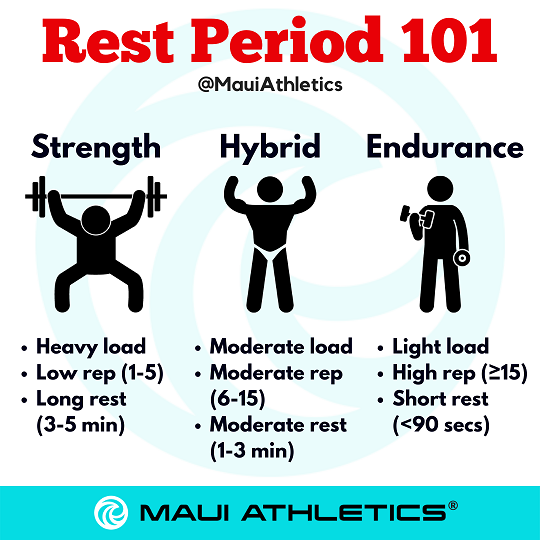Rest Periods and Resistance Programming
Rest Intervals
How much time should you rest between sets to maximize your training progress? In this article I will discuss the rationale for why you would want to optimize your rest periods for progress purposes as well as how to properly plan rest periods depending on the musculature involved, goal, and general rep ranges used.
For those looking to cut through the details, head to the Summary section at the end!
Rationale
Rest periods between sets provide modest benefits in the short-term that can add up to significantly more total work (reps, sets, load) over time. Increasing work, within reason, yields greater results in strength, endurance, and muscular development.1 Often times too short of a rest period can be detrimental to overall recovery and total training volume. Schoenfeld et al found: “Longer rest periods promote greater increases in muscle strength and hypertrophy”.2 The researchers compared 1 to 3 minute rest intervals using full body compound workouts and found maximal strength and muscle thickness were both greater in the 3 minute interval period.
Additional research has investigated the use of rest periods in an attempt to gain a benefit from acute hormonal responses, however this does not seem to have any practical use as hormonal response is highly variable and may not necessarily be predictive of strength and lean tissue gains.4
But what happens if we let our own perception of fatigue guide our rest? “Highly trained strength athletes demonstrated a significant difference in their between session power output and total rest time when using self-selected interset rest periods, despite stability in their subjective ratings of fatigue and effort. Interset rest periods can be self-selected reliably to complete strength training in heavy squat protocol; however, power output may decline during the set.”5 Our own self-assessed measures of fatigue may not be the best way to maximize returns during training. So then how do we maximize efficiency, muscular recovery, and benefit of a workout?
Planning
It is prudent to tailor your specific rest periods based on the type of movement/muscles involved, rep range, your goals, and the fatigue that would be present during that period of your overall workout.
According to the American College of Sports Medicine position stand: “It is recommended that strength programs sequence exercises to optimize the preservation of exercise intensity (large before small muscle group exercises, multiple-joint exercises before single-joint exercises, and higher-intensity before lower-intensity exercises). For novice (untrained individuals with no RT experience or who have not trained for several years) training, it is recommended that loads correspond to a repetition range of an 8-12 repetition maximum (RM). For intermediate (individuals with approximately 6 months of consistent RT experience) to advanced (individuals with years of RT experience) training, it is recommended that individuals use a wider loading range from 1 to 12 RM in a periodized fashion with eventual emphasis on heavy loading (1-6 RM) using 3- to 5-min rest periods between sets performed at a moderate contraction velocity (1-2 s CON; 1-2 s ECC).
When training at a specific RM load, it is recommended that 2-10% increase in load be applied when the individual can perform the current workload for one to two repetitions over the desired number. The recommendation for training frequency is 2-3 d x wk(-1) for novice training, 3-4 d x wk(-1) for intermediate training, and 4-5 d x wk(-1) for advanced training. Similar program designs are recommended for hypertrophy training with respect to exercise selection and frequency.
For loading, it is recommended that loads corresponding to 1-12 RM be used in periodized fashion with emphasis on the 6-12 RM zone using 1- to 2-min rest periods between sets at a moderate velocity. Higher volume, multiple-set programs are recommended for maximizing hypertrophy. Progression in power training entails two general loading strategies: 1) strength training and 2) use of light loads (0-60% of 1 RM for lower body exercises; 30-60% of 1 RM for upper body exercises) performed at a fast contraction velocity with 3-5 min of rest between sets for multiple sets per exercise (three to five sets). It is also recommended that emphasis be placed on multiple-joint exercises especially those involving the total body. For local muscular endurance training, it is recommended that light to moderate loads (40-60% of 1 RM) be performed for high repetitions (>15) using short rest periods (<90 s).
In the interpretation of this position stand as with prior ones, recommendations should be applied in context and should be contingent upon an individual’s target goals, physical capacity, and training status.”3
Additionally:
Summary
For hypertrophy/hybrid goals, it would be smart to consider a 1-3 minute rest interval (depending on the muscle being targeted and whether compound vs isolation). Abs, calves and traps, for instance, tend to recover faster and can therefore benefit from shorter rest periods. Larger muscle group compound exercises such as deadlift, squat, and bench press would benefit from a 2-3 min rest period during hypertrophy training.
For strength goals, it would be smart to consider a 3-5 minute rest interval. Because of the heavier load lifted during these exercises, more time is required for adequate recovery between sets. Larger muscle group compound exercises such as deadlift, squat, and bench press would benefit from a ~4 min rest period during strength training.
For local muscular endurance training, it is recommended that light to moderate loads be performed for high repetitions (>15) using short rest period of <90 seconds.
Citations
- https://www.ncbi.nlm.nih.gov/pubmed/20847704
- https://www.ncbi.nlm.nih.gov/pubmed/26605807
- https://www.ncbi.nlm.nih.gov/pubmed/19204579
- https://www.ncbi.nlm.nih.gov/pubmed/19077743
- https://www.ncbi.nlm.nih.gov/pubmed/30866743
- DOI: 10.1519/JSC.0000000000001272
- DOI: 10.1055/s-0042-119204









